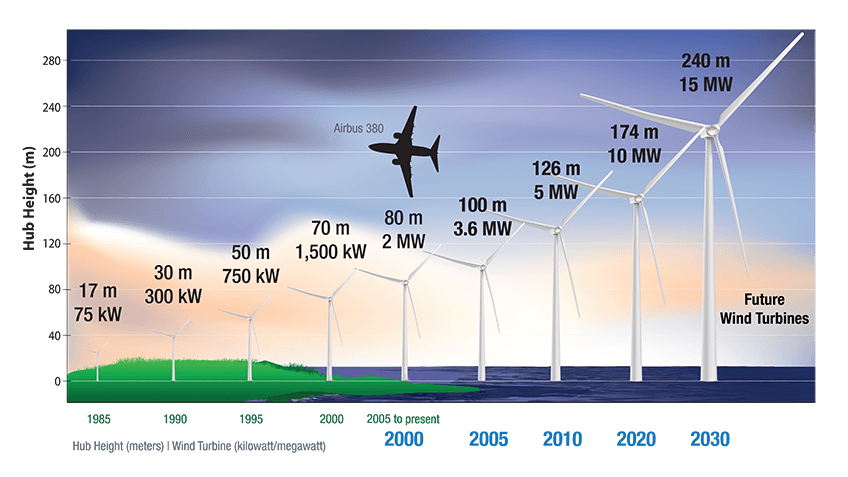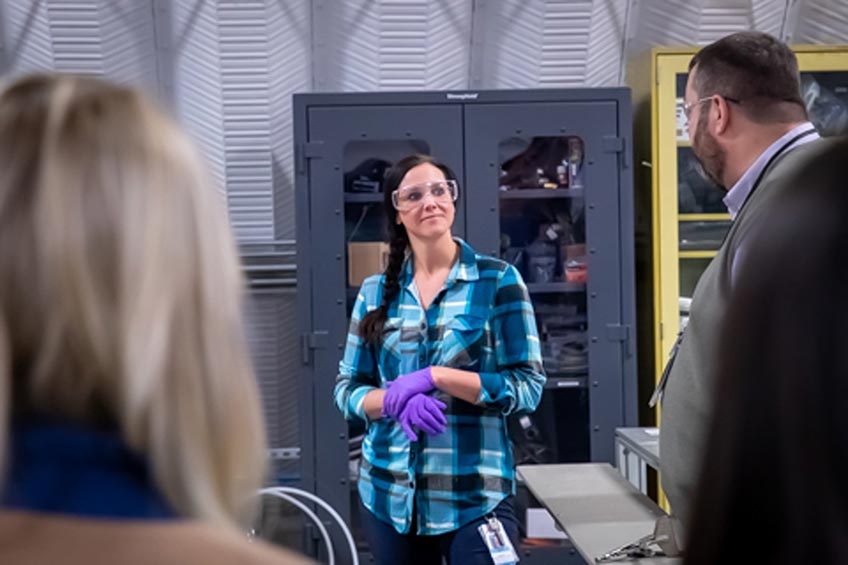The Leading Edge: April 2020 Wind Energy Newsletter
In this edition of The Leading Edge, we cover the National Renewable Energy Laboratory's (NREL's) floating offshore wind research, efforts to protect bat species, and a demonstration of new wind turbine blade manufacturing technology.
News Stories
Floating Wind Turbines on the Rise
Over 26,000 megawatts (MW) of planned offshore wind capacity exists in the offshore wind development pipeline. Rapidly falling technology costs for offshore wind, including floating offshore wind technology, have aided the growth of this pipeline and promise to help wind become a significant part of the power mix in coastal communities.
To help explain the strong tailwinds in the offshore industry, NREL Offshore Wind Research Platform Lead Walter Musial, one of the nation's foremost offshore wind experts, summarized the latest information in a recent "Overview of Floating Offshore Wind" webinar.

NREL Research Makes Skies Safer for Bats
Bats are notoriously difficult to study, and there is still much we don't know about them. To help improve understanding of bats and their behavior around wind turbines, NREL is collaborating on several research and development projects funded by the U.S. Department of Energy (DOE) Wind Energy Technologies Office. These efforts are helping minimize wind turbine-bat impacts through monitoring, deterrence, and curtailment.
NREL Demonstrates New Wind Turbine Blade Manufacturing Methods and Technology
Researchers at NREL's Flatirons Campus demonstrated a new, advanced material used to manufacture wind turbine blades to industry representatives during a Women in Manufacturing event at the Composites Manufacturing Education and Technology facility. NREL partnered with the Women in Manufacturing Association's Colorado Chapter to organize and host the event, which included a tour and networking reception.

Downwind – In Case You Missed It
NREL Extends Deadline for DOE Competitiveness Improvement Project Proposals to May 5
NREL has extended DOE's Competitiveness Improvement Project (CIP) distributed wind request for proposals submission deadline.
The new proposal deadline is May 5 at 2 p.m. Mountain Daylight Time.
Publications
Comparison of Rotor Wake Identification and Characterization Methods for the Analysis
of Wake Dynamics and Evolution
This study is the first time an intercomparison of analysis methods for wind turbine
wake evolution and dynamics has been performed. The researchers developed a new method
for identifying and characterizing wakes and compared this method with other established
approaches, revealing uncertainties in the predicted wake expansion, recovery, and
motion—all affecting wind plant performance and efficiency—based on the choice of
approach and assumptions made by a reasonable analyst. These insights directly impact
our understanding of wind turbine wake physics and validation efforts for engineering
wake models, which ultimately drive optimal wind power plant design.
Exascale Applications: Skin in the Game
This article provides an overview of applications under development through DOE's
Exascale Computing Project that seek to couple science-based computational applications
with the power of exascale high-performance computing technologies. The ExaWind application is designed to advance fundamental understanding of the flow physics governing whole wind power
plant performance.
IEA Wind TCP Task 37: Definition of the IEA 15-Megawatt Offshore Reference Wind Turbine
This report discusses the release and specifications of the International Energy Agency (IEA) Wind 15-MW reference turbine, which provides engineers and designers a tool to advance better-performing, more
cost-competitive offshore wind turbines. Developed in collaboration with the Technological
University of Denmark and the University of Maine, the reference turbine's configurations
go beyond the capabilities of the 10- to 12-MW wind turbines already in development by the industry and serve as a baseline for next-generation designs.
Offshore Wind Turbines Will Encounter Very Low Atmospheric Turbulence
Using 13 months of lidar observations off the coast of Massachusetts, researchers
determined that offshore wind plants at the site of study will experience very low
turbulence. However, large wind veer conditions that often occur during low-turbulence
regimes can impact the effectiveness of wake-steering solutions. The study concludes
that both turbulence and veer regimes should be considered when studying optimal layout
solutions for the offshore wind farms currently being planned in the U.S. Eastern
Seaboard to minimize wake losses and increase offshore wind energy production.
The Importance of Round-Robin Validation When Assessing Machine-Learning-Based Vertical
Extrapolation of Wind Speeds
An accurate assessment of the wind resource at hub height is necessary for an efficient
and bankable wind farm project. Conventional techniques for wind speed vertical extrapolation
include a power law and logarithmic law. This article proposes a round-robin validation
to assess the benefits that a machine learning-based approach can provide in vertically
extrapolating wind speed at a location different from the training site—the most practically
useful application for the wind energy industry.
Short-Term Wind Forecasting Using Statistical Models with a Fully Observable Wind
Flow
In this article, researchers find that synthetic data—data generated by a computer
system using inputs from real-world observations—could improve atmospheric forecasting.
The larger set of inputs synthetic data provide can help researchers observe the full
wind flow field in a specified region, and this study shows that short-term forecasts
using this regional synthetic data perform comparably to studies that use observational
data. These results provide motivation to use synthetic data for short-term forecasting
in grid simulations and open the door to future algorithmic improvements.
Share

